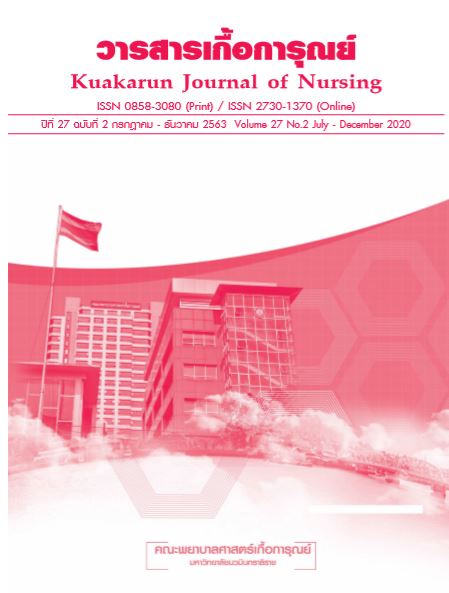การวิเคราะห์องค์ประกอบเชิงยืนยันการคล้อยตามกลุ่มอ้างอิง พฤติกรรมการบริโภคอาหารบรรจุโฟม
คำสำคัญ:
การวิเคราะห์องค์ประกอบเชิงยืนยัน, การคล้อยตามกลุ่มอ้างอิง, ผู้บริโภคบทคัดย่อ
การวิจัยเชิงปริมาณนี้มีวัตถุประสงค์ เพื่อวิเคราะห์องค์ประกอบเชิงยืนยันการคล้อยตามกลุ่มอ้างอิงของพฤติกรรมการบริโภคอาหารบรรจุโฟม และตรวจสอบความตรงเชิงโครงสร้างของโมเดลกับข้อมูลเชิงประจักษ์ เก็บข้อมูลด้วยแบบสอบถาม ซึ่งสร้างจากแนวทางการสร้างแบบสอบถามของทฤษฎีพฤติกรรมตามแผน 1 ฉบับ ประกอบด้วยแบบสอบถามข้อมูลทั่วไป เพศ อายุ ระดับการศึกษาสูงสุด อาชีพในปัจจุบันรายได้ต่อเดือน และแบบสอบถามข้อคิดเห็นเกี่ยวกับการคล้อยตามกลุ่มอ้างอิง จานวน 3 ด้าน คือ ด้านการคล้อยตามกลุ่มอ้างอิงครอบครัว ด้านการคล้อยตามกลุ่มอ้างอิงเพื่อน และด้านการคล้อยตามกลุ่มอ้างอิงสังคม มีค่าความเชื่อมั่นภายในเท่ากับ .88 ประชากรกลุ่มเป้าหมาย คือ ผู้บริโภคที่มีประสบการณ์การบริโภคอาหารบรรจุโฟมในพื้นที่อำเภอหาดใหญ่ จังหวัดสงขลา จำนวน 280 คน สุ่มตัวอย่างด้วยเทคนิคการสุ่มตัวอย่างแบบกลุ่ม วิเคราะห์ข้อมูลพื้นฐานด้วยสถิติเชิงพรรณนา และวิธีวิเคราะห์องค์ประกอบเชิงยืนยัน
ผลการวิเคราะห์ และตรวจสอบองค์ประกอบเชิงยืนยันการคล้อยตามกลุ่มอ้างอิงของพฤติกรรมการบริโภคอาหารบรรจุโฟมประกอบด้วย 3 ตัวชี้วัด คือ การคล้อยตามกลุ่มอ้างอิงครอบครัว เพื่อน และสังคม เมื่อพิจารณาค่าดัชนีความสอดคล้องกลมกลืน ประกอบด้วย χ2 = .25, df = 1.00, p-value = .61, RMSEA = .00, RMR = .00, CFI = 1.00, GFI = 1.00 แต่ละตัวชี้วัดขององค์ประกอบหลักมีค่าน้ำหนักองค์ประกอบมาตรฐานอยู่ระหว่าง .50 – .95 โดยมีค่าสัมประสิทธิ์ความเที่ยงของตัวแปรสังเกตได้ (R2) อยู่ระหว่าง .25 - .91 ซึ่งตัวชี้วัดที่มีค่าน้ำหนักสูงสุด ได้แก่ การคล้อยตามกลุ่มอ้างอิงครอบครัว และน้อยที่สุด คือ การคล้อยตามกลุ่มอ้างอิงสังคม ข้อเสนอแนะคือ หน่วยงานที่เกี่ยวข้องควรส่งเสริมให้สถาบันครอบครัว หรือบุคคลใกล้ชิดประพฤติตนเป็นต้นแบบสำคัญในการปฏิบัติตนงดเว้นพฤติกรรมการบริโภคอาหารบรรจุโฟมหรือภาคสังคมควรพัฒนานโยบาย หรือกิจกรรมสร้างกระแสรณรงค์ ที่มีประสิทธิผลสำหรับปรับเปลี่ยนพฤติกรรมสุขภาพ เป็นแบบอย่างทำให้เกิดสังคมไร้โฟม เสริมสร้างความรู้ความเข้าใจให้ประชาชนปรับเปลี่ยนทัศนคติที่มีต่อการบริโภคอาหารบรรจุโฟม ก่อให้เกิดการปรับเปลี่ยนพฤติกรรมการบริโภคที่เหมาะสมต่อไปอย่างยั่งยืน
เอกสารอ้างอิง
World Health Organization. World health statistics 2017: monitoring health for the SDGs, Sustainable Development Goals. Switzerland: L’IV Com Sàrl, Villars-sous-Yens; 2017.
Ministry of Public Health. Mortality rate per population (100,000 people) classified by cause of death and gender, Songkhla Province, 2007 – 2014 [Internet]. 2014 [cited 2017 Sep 18]. Available from: http://service.nso.go.th/nso/web/statseries/statseries09.html (in Thai)
Factory Environmental Management Group. Environmental management for the plastic packaging industry. Bangkok: Department of Industrial Works; 2013. (in Thai)
Rossida C. Risk assessment from polystyrene monomers moving from polystyrene foam food containers into food [Dissertation]. Khon Kaen: Khon Kaen University; 2009. (in Thai)
Boriboon U. Data from laboratories about polystyrene. Paper presented at: the academic exchange meeting on silent threat from foam food containers. Nonthaburi: Ministry of Public Health; 2015. (in Thai)
Songkhla Provincial Public Health Office. Mortality situation data [Internet]. 2017 [cited 2018 Feb 6]. Available from: http://www.skho.moph.go.th/dataservice (in Thai)
Songkhla Provincial Public Health Office. Liver cancer patients [Internet]. 2018 [cited 2018 Mar 30]. Available from: http://chronic.skho.moph.go.th/chronic/rep_ptcaliver.php (in Thai)
Schiffman LG, Kanuk LL. Consumer behavior. 9th ed. New Jersey: Pearson Prentice Hall America; 2007.
Ajzen I. The theory of planned behavior. Organ Behav Hum Decis Process 1991;50(2):179-211.
Ajzen I. Constructing a TPB questionnaire: conceptual and methodological considerations [Internet]. 2006 [cited 2017 Sep 1] Available from: http://people.umass.edu/aizen/pdf/ tpb.measurement.pdf
Jamornmann U. Educational tests and measurements. 3th ed. Bangkok: Funny Publishing; 2001. (in Thai)
Joseph F Hair Jr, William CB, Barry JB, Rolph EA. Multivariate data analysis. 7th ed. New York: Pearson New International Edition; 2010.
Tirakanan S. Construction of variable measuring instrument in social science research: a guide to practice. Bangkok: Chulalongkorn University; 2007. (in Thai)
Wiratchai N. Lisrel: analytical statistics for research. 3rd ed. Bangkok: Chulalongkorn University; 1999. (in Thai)
Euromonitor international. Eco worriers: global green behavior and market impact. London: Euromonitor international; 2015.
Chokenukul P. A causal relationship model of fish processing product purchasing behavior of consumer in Thailand [Dissertation]. Songkhla: Prince of Songkhla University; 2017. (in Thai)
Hawkins DI, Mothersbaugh DL. Consumer behavior building marketing strategy. 12th ed. New York: MaGraw-Hill; 2013.
Philip K, Keller KL. Marketing management. 13th ed. New Jersey: Prentice-Hall; 2009.
Sobal J, Bissogni CA, Devine CM, Jastran M. A conceptual model of the food choice process over the life course. In: Shepherd R, Ratts M, editors. The psychology of food choice; UK: AMA DataSet; 2006. p. 1-18.
Qi X, Ploeger A. Explaining consumers’ intentions towards purchasing green food in Qingdao, China: the amendment and extension of the theory of planned behavior. Appetite 2019;133(1):414-22.
Shih-Chih C, Chung-Wen H. Elucidating the factors influencing the acceptance of green products: an extension of theory of planned behavior. Technological Forecasting and Social Change 2016;112(1):155-63.















